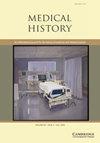Acroagonines: Ugo Cerletti’s audacious attempt to place the neurophysiological effects of electroconvulsive therapy in vials
IF 1.1
2区 哲学
Q4 HEALTH CARE SCIENCES & SERVICES
引用次数: 0
Abstract
Abstract In the years 1947–57, following a turbulent retirement, Ugo Cerletti, the father of electroconvulsive therapy (ECT) (1938), invested his energies in a new audacious project conceived as an extension of his ECT research. Forced to leave the direction of the Sapienza University Clinic, he got funds from the National Research Council of Italy to carry out his experimental activities, and founded a ‘Center for the study of the physiopathology of Electro-shock’ in Rome. The Center was aimed at studying liquid substances extracted from electro-shocked animals’ brains that Cerletti named acroagonine and injected into human patients. Inspired by coeval literature, Cerletti believed that electroshock efficacy was due to stimulating some homeostatic processes in the brain, specifically in the meso-diencephalic area (i.e. involving neuroendocrine response in the hypothalamic–pituitary–adrenal axis). Cerletti’s team wished not only to find these effects, but also to reproduce them. With this hypothesis, that proved ineffective, Cerletti anticipated intuitions on the neuroendocrine effects of ECT and the necessity for the development of psychopharmacology. In this article, I cross-combined previously unexplored archival materials stored at Sapienza University of Rome (‘ES Section’) with established bibliographic and archival sources.阿Acroagonines: Ugo Cerletti大胆尝试将电休克治疗的神经生理效应放在小瓶中
1947年至1957年,电休克疗法(ECT)之父乌戈·塞莱蒂(Ugo Cerletti, 1938年)经历了一段动荡的退休生活后,将精力投入到一个新的大胆项目中,该项目被认为是他的ECT研究的延伸。在被迫离开萨皮恩扎大学诊所的指导下,他从意大利国家研究委员会获得了开展实验活动的资金,并在罗马建立了一个“电击生理学研究中心”。该中心旨在研究从受到电击的动物大脑中提取的液体物质,Cerletti将其命名为acroagonine,并将其注射到人类患者体内。受同期文献的启发,Cerletti认为电击的效果是由于刺激了大脑中的一些稳态过程,特别是中间脑区(即涉及下丘脑-垂体-肾上腺轴的神经内分泌反应)。Cerletti的团队不仅希望找到这些效应,而且希望重现它们。有了这个被证明是无效的假设,Cerletti预测了电痉挛疗法对神经内分泌的影响,以及发展精神药理学的必要性。在这篇文章中,我将罗马大学(“ES部分”)储存的以前未开发的档案材料与已建立的书目和档案来源交叉结合。
本文章由计算机程序翻译,如有差异,请以英文原文为准。
求助全文
约1分钟内获得全文
求助全文
来源期刊

Medical History
医学-科学史与科学哲学
CiteScore
1.60
自引率
0.00%
发文量
25
审稿时长
>12 weeks
期刊介绍:
Medical History is a refereed journal devoted to all aspects of the history of medicine and health, with the goal of broadening and deepening the understanding of the field, in the widest sense, by historical studies of the highest quality. It is also the journal of the European Association for the History of Medicine and Health. The membership of the Editorial Board, which includes senior members of the EAHMH, reflects the commitment to the finest international standards in refereeing of submitted papers and the reviewing of books. The journal publishes in English, but welcomes submissions from scholars for whom English is not a first language; language and copy-editing assistance will be provided wherever possible.
 求助内容:
求助内容: 应助结果提醒方式:
应助结果提醒方式:


